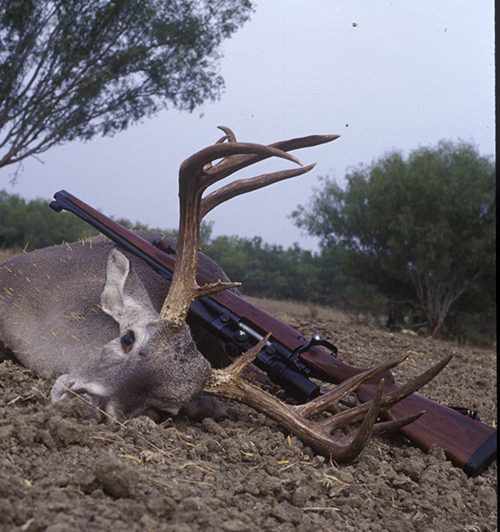
ALTHOUGH MANY SUSPECT the extended drought which struck during the critical spring antler development period thwarted antler growth, Texas still produces many fine deer. Hunters still might take the buck of a lifetime in several regions this season. (Photo by John Jefferson)
by John Jefferson
But did it help their antlers?
TPW’s deer hunting forecast was somewhat dismal due to drought, so I decided to consult several deer managers on conditions since the rains came in popular hunting areas.
First, I contacted the staff at the Kerr Wildlife Management Area west of Kerrville in the Hill Country. That region has the highest deer density in Texas, and the most hunters.
Evan McCoy, on the Kerr, told me that fall rains occurring in September and October really improved the habitat. Everything has greened up and the deer are finally getting enough to eat. They’ve only had one of their drawn public hunts so far and it was a successful youth hunt.
They also had a drawn either-sex hunt. He did say there was a wide range of quality among antlers. He felt they hadn’t seen many harvested bucks in the trophy buck category, and that antler quality might be a little off compared to other years. He felt this would apply throughout most of the Edwards Plateau.
A good acorn drop has helped as far as nourishment is concerned, but the drought during spring antler development period probably did affect the bucks. There will still be bucks, though, that will make hunters proud. Well-managed ranches will probably see better bucks. The Kerr Area has some of the best managed habitat in the hills.
McCoy said there could be some stand-by slots open up for some of the remaining hunts. Call shortly before the hunts to verify: (830) 238-4483.
North of the Hill Country lies the Cross Timbers Region, which also has a high deer density and somewhat similar conditions to conditions to the Hill Country.
Johnny Hudman has been a long-time hunter and guide in the Rolling Plains, working the San Angelo-Abilene-Albany area. He says the drought affected the fawn crop as well as the antlers. He told of one buck that had nice antlers last season but has not developed that well this year. Its antlers seemed brittle, and it had already broken a tine.
The Rolling Plains has a lower deer population than other regions but has produced many fine racks. Hudman says this this year’s will probably not score as high as last year‘s.
Little Roy Hindes is probably the best-known deer-trailer in Texas due to the trailing dogs his father began working with years ago. Little Roy continued the work. He has trailed deer on many ranches in South Texas and Mexico.
The drought forced Hindes to start selling cattle the week before the rains came. Although they fell too late to help with antler development, he says they’ve greatly improved the habitat. Regardless, he knows of fine antlered deer having been taken in Webb County and others from near Freer where that country received 24-inches of rain. Another came from Frio County and one from a low-fenced ranch near Batesville.
Overall, 2022 is a lesser year than 2021, but this is Texas. Even an off year here produces memorable bucks.
JJ




